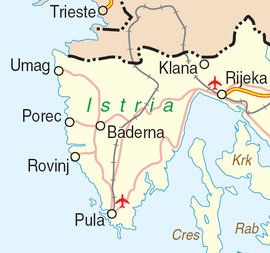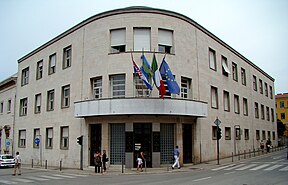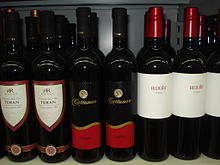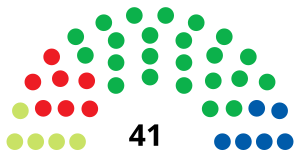"County of Istria" redirects here. For the historical county, see March of Istria. County in Croatia
| Istria County
Istarska županija (Croatian) Regione istriana (Italian) | |
|---|---|
| County | |
       | |
 Flag Flag Coat of arms Coat of arms | |
| Anthem: Krasna zemljo (Croatian) "Beautiful land" | |
 Istria County within Croatia Istria County within Croatia | |
| Country | Croatia |
| County seat Largest City | Pazin Pula |
| Government | |
| • Župan | Boris Miletić (Ind.) |
| • Assembly | 41 members |
| Area | |
| • Total | 2,813 km (1,086 sq mi) |
| Population | |
| • Total | 195,794 |
| • Density | 70/km (180/sq mi) |
| Languages | |
| • Official languages | Croatian and Italian |
| Area code | 052 |
| ISO 3166 code | HR-18 |
| HDI (2022) | 0.896 very high · 3rd |
| Website | www |
Istria County (/ˈɪstriə/; Croatian: Istarska županija; Italian: Regione istriana, lit. "Istrian Region") is the westernmost county of Croatia which includes the majority of the Istrian peninsula.
Administrative centers in the county are Pazin, Pula and Poreč. Istria County has the largest Italian-speaking population in Croatia. It borders Slovenia.
History
The caves near Pula (in latinium Pietas Julia), Lim bay, Šandalja, and Roumald's cave, house Stone Age archaeological remains. Less ancient Stone Age sites, from the period between 6000 and 2000 BC can also be found in the area. More than 400 locations are classified as Bronze Age (1800–1000 BC) items. Numerous findings including weapons, tools, and jewelry) which are from the earlier iron era around the beginning of common era.
The Istrian peninsula was known to Romans as the terra magica. Its name is derived from the Histri, an Illyrian tribe who as accounted by the geographer Strabo lived in the region. Romans described them as pirates who were hard to conquer due to the difficulty of navigating the territory. After two military campaigns, Roman legions finally subdued them in 177 BC.
With the fall of the Western Roman Empire in 476, Istria was conquered by the Goths and then by the Byzantines. During Byzantine rule, it was shortly ruled by Avars. Istria was annexed by the Lombards in 751, by the Avars in 774, by the Franks during the reign of Charlemagne in 789, and successively controlled by various dukes, (Carinthia, Merano, Bavaria). Later it was run by the patriarchs of Aquileia.
In 1267 the Republic of Venice annexed the western and southern coast of the Istrian peninsula because of the strong presence of the autochthonous Italian community; during this period the region prospered. The major Istrian cities were reborn under Venetian government; it was in this half millennium that they developed architecturally and culturally. The eastern half of Istria was administered by the Habsburgs, and was referred to as "Imperial Istria" with its capital at Pisino (German: Mitterburg).
In 1797, with the Treaty of Campo Formio written by Napoleon, the peninsula with the whole Republic of Venice passed to the Habsburgs of Austria. The Treaty of Pressburg in 1805 handed Istria to the Kingdom of Italy. The Treaty of Schönbrunn in 1809 transferred Istria to France. In 1815, the Congress of Vienna confirmed Austria's possession on the Northern Adriatic Sea along with Istria. Regional guvernative units were formed in Gorizia (Gorizia county), Trieste (Istrian area), and Rijeka (Pazin county and Kvarner Gulf). From 1849 they were united in Austrian Littoral. The free port of Trieste presented an individual guvernative unit outside of other guvernative areas. Starting in 1861 until 1918/1920 the seat to a regional Parliament in the Austro-Hungarian Empire was in Parenzo (today: Poreč).
After World War I, according to the peace treaty of Rapallo Istria became part of Italy in 1920. Fascism and later Nazi occupation spoiled otherwise tolerant ethnic relations in the area. After World War II Istria was assigned to Yugoslavia and many ethnic Italians (Istrian Italians) left in the Istrian–Dalmatian exodus. With the collapse of Communist Yugoslavia Istria became part of an independent Croatia and the region saw no fighting in the ensuing war. Today it is one of the most economically developed parts of Croatia. Currently, some people ask for a higher degree of autonomy for the county. This is part of the Istrian regionalist movement.
Personalities like Robert Koch and writer James Joyce lived and worked in Istria. Writer Jules Verne was inspired to write his novel Mathias Sandorf after hearing of the quarry and cave in Pazin and the poet Dante Alighieri visited and wrote a few lines about Istria. Racing drivers Mario Andretti and Aldo Andretti were born in Montona in Istria.
Geography

Its coastline is 445 km (277 mi) long with islands making up 539.9 km (335 mi). A smaller part of Istria also belongs to the Primorje-Gorski Kotar County of Croatia. Mirroring the bay of Venice across the Adriatic and the Quarnaro Gulf, the region is not far from the Julian Alps. The westernmost point is at Savudrija while the southernmost is near Premantura, on the local promontory of Kamenjak.
The terrain consists of a limestone plateau much of which lacks water owing to its karst topography. The northeastern section is an extension of the Dinaric Alps. The highest point is Vojak on Učka mountain 1,401 m (4,596.46 ft) above sea level and there is another range of mountains, the Ćićarija.
There are so called "bijela", "siva", and "crvena" Istra (white, grey and red Istria). White Istria is around the mountain peaks, Grey Istria is the fertile inner lands while Red Istria is the blood-red painted lands of terra rossa or "crljenica" near the coastline.
Sites such as the Grotto of Baredine near Poreč, the underground river Pazinčica, and the karst Pazin pit (Pazinska jama) near Pazin are geologic attractions. The Limski Kanal is the only structure resembling a fjord in continental Europe outside of Scandinavia (though actually it is not a fjord, but a ria). The quarry near Rovinj has been designed for studying geology. The longest river, the Mirna is only 32 km (20 mi) long and its mouth is near Novigrad. Other rivers that pass through Istria include the Dragonja River and the Raša River.
The continental plains and valleys are primarily utilized for agriculture, such as growing cereals and vegetables. Closer to the sea, red lands are used for cultivation of grapes, vine, olives, and figs. Agriculture and the production of ecological food, the olive gardens, and the production of quality wines is the focus of Istria's agriculture sector. The coastline and nearby islands are rich in the maquis shrubland (mostly holm oak and strawberry tree). Woods, mostly oak and pine trees, cover a third of the territory.
The Brijuni national park and the Učka nature park are well-known natural reservations and legally protected landscapes. This mountain range feeds the rivers and lakes from eastern Istria to the Raša river in the Labinština peninsula. Other interesting localities are Lim Bay, the wood near Motovun, park woods Zlatni Rt and Šijana near Pula, the protected landscape of Kamenjak in the extreme south of Istria, and the reservation Palud with an ornithology near Rovinj. The Brijuni archipelago is an interesting habitat of about 680 plant species and also decorated by the most diverse vegetation and olive groves.
Climate
Protected from the north by the mountain chain of Alps as well the inner highland, the climate is borderline Mediterranean and humid subtropical with wetter winters and drier summers, but not completely dry. Overall a very pleasant climate with the highest air temperature averaging 24 °C during August, and the lowest air temperature averaging 5 °C in January. Summers are usually warm during the day and cooler near the evening, although strange heat wave patterns are common. The weather ranges from humid to dry with over 10 hours of sunshine daily. Primarily, there is a lot of moisture in the air especially in the coastal towns of Istra such as Poreč, Vrsar, Rovinj, Pula, and others. Temperatures above 10 °C last for more than 240 days a year. Excessive heat (above 30 °C) lasts for three weeks at the most. Despite air temperatures being lower than those in Dalmatia, the Adriatic Sea is warmer reaching up to 26 °C in August, coldest in March, (9-11 °C), while the freezing even in small, shallow bays is quite rare. There are two kinds of winds - the bora is bringing cold and clear weather from the north in winters, and the southern jugo bringing rain in summer. The maestral is a summer breeze blowing from the inland to the sea. The salinity of the sea water is 0.37%.
Demographics
| Year | Pop. | ±% |
|---|---|---|
| 1857 | 117,719 | — |
| 1869 | 133,518 | +13.4% |
| 1880 | 160,000 | +19.8% |
| 1890 | 176,196 | +10.1% |
| 1900 | 194,455 | +10.4% |
| 1910 | 236,981 | +21.9% |
| 1921 | 215,167 | −9.2% |
| 1931 | 223,949 | +4.1% |
| 1948 | 183,344 | −18.1% |
| 1953 | 175,094 | −4.5% |
| 1961 | 176,838 | +1.0% |
| 1971 | 175,199 | −0.9% |
| 1981 | 188,332 | +7.5% |
| 1991 | 204,346 | +8.5% |
| 2001 | 206,344 | +1.0% |
| 2011 | 208,055 | +0.8% |
| 2021 | 195,794 | −5.9% |
| Source: Naselja i stanovništvo Republike Hrvatske 1857–2001, Croatian Bureau of Statistics, Zagreb, 2005 | ||
According to the 2021 census the total population of Istria County is 195,794 which amounts to approxmiately 4.8% of Croatia's entire population. The county's population density is approximately 70 inhabitants per km with an average age of 45 years.
Istria County: Population trends 1857–2021| population | 117719 | 133518 | 160000 | 176196 | 194455 | 236981 | 215167 | 223949 | 183344 | 175094 | 176838 | 175199 | 188332 | 204346 | 206344 | 208055 | 195794 |
| 1857 | 1869 | 1880 | 1890 | 1900 | 1910 | 1921 | 1931 | 1948 | 1953 | 1961 | 1971 | 1981 | 1991 | 2001 | 2011 | 2021 |
Istria county is administratively subdivided into 41 local units of government - 10 of these are officially designated as cities/towns and 31 are largely rural municipalities. More than 70 percent of the county's population lives in these ten urban areas:
- Pula / Pola (57,460)
- Poreč / Parenzo (16,696)
- Rovinj / Rovigno (14,294)
- Umag / Umago (13,467)
- Labin / Albona (11,642)
- Pazin / Pisino (8,638)
- Buzet / Pinguente (6,133)
- Vodnjan / Dignano (6,119)
- Buje / Buie (5,182)
- Novigrad / Cittanova (4,345)
There are also 31 municipalities:
- Bale / Valle (1,127)
- Barban/ Barbana (2,721)
- Brtonigla / Verteneglio (1,626)
- Cerovlje / Cerreto (1,677)
- Fažana / Fasana (3,635)
- Gračišće / Gallignana (1,419)
- Grožnjan / Grisignana (736)
- Kanfanar / Canfanaro (1,543)
- Karojba / Caroiba (1,438)
- Kaštelir-Labinci / Castellier-Santa Domenica (1,463)
- Kršan / Chersano (2,951)
- Lanišće / Lanischie (329)
- Ližnjan / Lisignano (3,965)
- Lupoglav / Lupogliano (924)
- Marčana / Marzana (4,253)
- Medulin / Medolino (6,481)
- Motovun / Montona (1,004)
- Oprtalj / Portole (850)
- Pićan / Pedena (1,827)
- Raša / Arsia (3,183)
- Sveta Nedelja / Santa Domenica d'Albona (2,987)
- Sveti Lovreč / San Lorenzo di Pesenatico (1,015)
- Sveti Petar u Šumi / San Pietro di Selve (1,065)
- Svetvinčenat / Sanvincenti (2,202)
- Tar-Vabriga / Torre-Abrega (1,990)
- Tinjan / Antignana (1,684)
- Višnjan / Visignano (2,274)
- Vižinada / Visinada (1,158)
- Vrsar / Orsera (2,162)
- Žminj / Gimino (3,483)
- Funtana / Fontane (907)


 The Italian tricolour as flag of the autochthonous Italian minority is displayed alongside the Croatian and the Istrian flags on government buildings
The Italian tricolour as flag of the autochthonous Italian minority is displayed alongside the Croatian and the Istrian flags on government buildings
Besides official Croatian, the Chakavian dialect of Croatian is often in use, as in most coastal counties. Italian is also recognized in the county as an official language.
In 2021 the population was 195,237 and the main ethnic groups were as follows:
- Croats – 149,152 (76.40%)
- Regional affiliation – 10,025 (5.13%)
- Italians – 9,784 (5.01%)
- Serbs – 5,778 (2.98%)
- Bosniaks – 4,838 (2.48%)
- Albanians – 2,055 (1.05%)
Before World War I and until World War II, Istria contained a large autochthonous Romance language speaking community consisting of Venetian dialects, Istriot and Istro-Romanian along with Italian, plus various local Slavic dialects, some of which were likewise unique to Istria. Today, apart from the local dialects and official Croatian, one still finds in this region a small community of people, the Istro-Romanians, who speak Istro-Romanian, closely related to Romanian, other districts where Venetian dialects and Istriot are still spoken.
Due to its traditional bond with Europe and its level of international integration, in 1994 Istria County was the first Croatian region to become a member of the Assembly of European Regions.
Communication
Istria is well connected with the rest of Croatia and Europe. Due to its connection with a wider European area, road development suitably covers all needs and contributes to a balanced development of the coastal area and the Istrian interior.
Initially, the need for railroads in Istria was based upon fast development of industrial activities; shipbuilding, construction material, machine and electric industries, as well as Austrian military interests. After Vienna and Trieste were connected in 1876, the railway between Divača, (in today's Slovenia) and Pula, (122 km (76 mi) long with 21 km (13 mi) long branch Kanfanar - Rovinj), was opened. Despite numerous initiatives, the western parts of Istria have been connected with the railroad only in 1902, with construction of the Parenzana narrow-gauge railway. The 123.1 km (76 mi) long railway, was dismantled in 1935. To this day, Istria County's rail connections are only towards Slovenia, and despite the fact that some plans to build railroad tunnel through Učka mountain date from decades ago, there are no projections about financing and works are not scheduled to start any time soon. The connection to the rest of Croatian rail network is by HŽ national railways' bus service from the Lupoglav junction to the Rijeka Station via Učka road tunnel
Croatian Istria County's highway system is callen the "Istrian Y". A8 motorway connects the county to the rest of Croatia from Matulji (A7/ further A6) interchange through Učka Tunnel to Kanfanar interchange, and A9 motorway connects Pula via Kanfanar to Umag, connecting the county to Slovenian Istria and further to Italy.
The only significant airport with scheduled commercial service is Pula Airport. Large majority of flights are only seasonal.
Economy

Well-developed are processing industry, with traditional agriculture, sea fishing and growing, construction and production of construction materials (lime, cement, brick, stone), trade and transport. Most developed branches of industry are shipbuilding (In the early 1970s its Uljanik shipyard was building the biggest ships in the world as Berge Adria and others), metal processing, wood industry, furniture industry, automotive components industry, electric machines and appliances industry, glass, plastic, textile, tobacco industry. According to economic indicators, the leading activities are processing industry, tourism, and trade.
Great attention is being given to agriculture and the production of ecologic food, the wine and olive growing. Historically cultivated local wine varieties include Malvasia (white) and Teran (red).
Istrian olive growers are being included in the first international extra virgin olive oil guide Flos Olei since 2000s, with Istria being both second and then first in the world by number of the included olive growers for 8 years respectively. Istria was declared world's best olive oil region by this guide for 8 years in a row (2017-2024).
Tourism
Organized tourism in Istria goes back to the Romans, when emperor Vespasian, for the entertainment of that time, built the Pula Arena. During the reign of Austro-Hungarian Empire in (1866), Austrian and Hungarian royalty and aristocracy started visiting local resorts and discovered Poreč.
Significant efforts were made after World War II to develop the tourist infrastructure and to accentuate its importance. In combination with the natural environment, history and cultural heritage, investments resulted in developed and competitive service all along the western coast in Poreč, Pula, Rovinj, Umag, Novigrad, and Vrsar.
One growing trend among the centrally located cities, especially Kanfanar, is agritourism. Beginning with La Casa di Matiki in 1994 after the war, a number of eccentric agritouristic Bed and Breakfasts have sprung up in central Istria, providing opportunities for individuals, couples, and families to experience a very authentic Istrian experience while learning about the Istrian agricultural lifestyle.
In the eastern part, as part of another county, there are resorts like Rabac, Opatija. Istria was and still is the most important tourist destination in Croatia, hosting the western and central European visitors, mostly from Germany, Slovenia, Austria and Italy. Area is the most visited tourist region with 27% of all visitors and 35% of time spent in all of Croatia.
County government

The current Prefect of Istria County is Boris Miletić (Ind.).
The county assembly is composed of 41 representatives from the following political parties:
| Political party | Seats won | Government |
|---|---|---|
| IDS - ISU - ZS | 23 / 41 | Government |
| SDP | 7 / 41 | Opposition |
| HDZ | 6 / 41 | Opposition |
| We Can! - ORaH | 5 / 41 | Opposition |
Minority councils and representatives
Directly elected minority councils and representatives are tasked with consulting tasks for the local or regional authorities in which they are advocating for minority rights and interests, integration into public life and participation in the management of local affairs. At the 2023 Croatian national minorities councils and representatives elections Albanians, Bosniaks, Montenegrins (electing 22 members), Roma, Slovenes (electing 24 members), Serbs and Italians of Croatia each fulfilled legal requirements to elect 25 members minority councils of the Istria County while Czechs, Hungarians, Macedonians and Ukrainians of Croatia elected individual representatives with German, Russian and Slovak representatives remained unelected due to the lack of candidates. Numerous municipalities, towns or cities in the county elected their own local minority councils as well.
See also
- Castellieri culture
- Counties of Croatia
- History of Istria
- Istria
- Roman Catholic Diocese of Poreč and Pula
References
| This article needs additional citations for verification. Please help improve this article by adding citations to reliable sources. Unsourced material may be challenged and removed. Find sources: "Istria County" – news · newspapers · books · scholar · JSTOR (May 2010) (Learn how and when to remove this message) |
- Ostroški, Ljiljana, ed. (December 2015). Statistički ljetopis Republike Hrvatske 2015 [Statistical Yearbook of the Republic of Croatia 2015] (PDF). Statistical Yearbook of the Republic of Croatia (in Croatian and English). Vol. 47. Zagreb: Croatian Bureau of Statistics. p. 62. ISSN 1333-3305. Retrieved 27 December 2015.
- "Population by Age and Sex, by Settlements" (xlsx). Census of Population, Households and Dwellings in 2021. Zagreb: Croatian Bureau of Statistics. 2022.
- "Sub-national HDI - Area Database - Global Data Lab". hdi.globaldatalab.org. Retrieved 10 October 2024.
- "Regione Istriana: Struttura organizzativa" (in Italian). Archived from the original on 11 November 2018. Retrieved 11 November 2018.
- "Results" (xlsx). Census of Population, Households and Dwellings in 2021. Zagreb: Croatian Bureau of Statistics. 2022.
- "Skupština europskih regija (SER)" (in Croatian). Istria County. Archived from the original on 30 June 2012. Retrieved 19 July 2012.
- "Raška pruga". istra.lzmk.hr. Retrieved 7 April 2018.
- "Istria declared world's best olive oil region for 8th year". croatiaweek.com. Croatia Week. 6 September 2023. Retrieved 8 September 2023.
- Pavlović, Milan (4 October 2023). "Istra osmu godinu zaredom najjača maslinarska regija u svijetu". glasistre.hr (in Croatian). Glas Istre. Retrieved 8 October 2023.
- "DOLASCI I NOĆENJA TURISTA U ISTRI PO ZEMLJAMA PORIJEKLA" (PDF). Archived from the original (PDF) on 4 March 2016. Retrieved 19 July 2015.
- "Župan i zamjenici župana". Archived from the original on 21 October 2020.
- "Manjinski izbori prve nedjelje u svibnju, kreću i edukacije". T-portal. 13 March 2023. Retrieved 2 May 2023.
- ^ "Informacija o konačnim rezultatima izbora članova vijeća i izbora predstavnika nacionalnih manjina 2023. XVIII. ISTARSKA ŽUPANIJA" (PDF) (in Croatian). Državno izborno povjerenstvo Republike Hrvatske. 2023. p. 3-8. Retrieved 3 June 2023.
External links
- Official website
 (in Croatian, Italian, and English)
(in Croatian, Italian, and English)
| Subdivisions of Istria County | ||
|---|---|---|
| Cities and towns |  | |
| Municipalities | ||
| Counties of Croatia | |
|---|---|
45°14′21″N 13°56′19″E / 45.23917°N 13.93861°E / 45.23917; 13.93861
Categories: